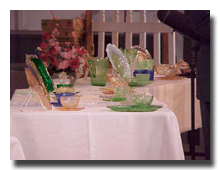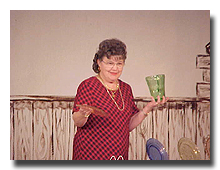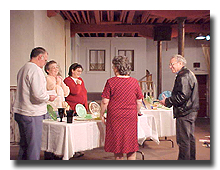SCOTTDALE - For
those
who lived through the Depres-
sion era, colorful glassware
given away at the movies or
packaged in a sack of flour was a
reminder of hard times.
Today, these plates, cups,
saucers and bowls are prized by
collectors for the different pat-
terns and rainbow of colors. 
Items to be talked about.
Depression Glass, as it is
known, is the topic of discussion
Sunday during "Parlor Talks" at
West Overton Museums here.
The lecture will begin at 2 p.m.
and is held in the Distillery The-
atre.
The lecturer, Edith Putanko,
is an authority on Depression
Glass and is familiar with the
glass-making history in the
Scottdale and Mount Pleasant
areas.
Putanko, of Bethel Park, has
been appearing at Mount Pleas-
ant's Glass and Ethnic Festival
for two years, letting visitors to
the festival know what their
glassware and china items are
worth.
Proprietor of Edie's Glass-
ware in Bethel Park, Putanko is
also a member and former presi-
dent of the Three River's Depres-
sion Era Glass Society and can
be seen on KDKA television's
Saturday morning news seg-
ment, "What's It Worth?" She has
been an appraiser since 1977 and
now travels across the United
States, attending Depression
Glass trade shows as a dealer.
She herself is a collector of
Depression-era glassware with a
collection that is "five china clos-
ets full and doesn't all fit."
"The glass industry was the
biggest employer in Pittsburgh,"
Putanko notes.
The Scottdale and Mount
Pleasant areas also have a tradi-
tion of glass-making which, iron-
ically enough, began at the West
Overton village.
According to Rodney Sturtz,
director of the museum, Andrew
Bryce, of the former Bryce
Brothers Glass Company, began
his glass-making career at West
Overton when he produced
molds for embossed glass bottles
for whiskey being distilled by
Abraham Overholt.
Sturtz says that Bryce then
moved into nearby Mount Pleas-
ant Borough where he began
manufacturing salt and pepper
shakers. Bryce eventually select-
ed a site for a new plant in the
borough and went on to become
the standard for the crystal
industry.
Some pieces of Bryce Broth-
ers' glass, a catalog from 1915 and
those embossed whiskey bottles
are on display at the museum,
Sturtz says.
Putanko herself has several
pieces of Bryce Brothers' glass
and pieces manufactured by L.E.
Smith, also in Mount Pleasant,
which purchased the Bryce fac-
tory. She says L.E. Smith was a
large manufacturer of black-col-
ored glass.
Putanko says she will display
several examples from Bryce and
L.E. Smith in addition to plates,
cups and saucers representative
of Depression Glass patterns.
Putanko, as a dealer, believes
that Bryce glass is not as well
known as other manufacturers
of elegant glass, such as Cam-
bridge, because it was not writ-
ten about.
"Bryce glass is very much
unappreciated outside of its
home area," she says. "It was not
given recognition of being such
good glass. There isn't a pattern
associated with being Bryce."
However, "Bryce pieces are of
of very good quality, " she com-
ments.
Depression Glass was pro-
duced in the U.S. during the
Depression years of late 1920's
through 1940's, though Putanko
says some companies manufac-
tured glass through the 1950's.

Edie describing a few pieces of
Depression Glassware.
Depression Glass was mass-
produced and machine made;
molten glass was poured into a
patterned mold which could be
etched or left plain, according to
the Glass Encyclopedia.
The pieces were produced in
a myriad of colors - pink, yel-
low, green, red, blue, purple, and
their deeper hues. Generally,
Depression Glass was manufac-
tured as tableware and kitchen
ware: cups, saucers, plates and
spice jars, for example.
Elegant Glass is the name
given to pieces that were hand-
made in the late Depression and
were purchased at department
stores, the Glass Encyclopedia
states.
Putanko describes Depression
Glass as "down-to-earth" because
it was manufactured in great
quantities and was given away.
She says the patterns on glass
covered mistakes in the manu-
facturing which wasn't an exact
science; often the formulas to
obtain a color weren't written
down and employees used a dif-
ferent amount of batch. Finally,
the coloring of glass could be
affected by the temperature of
heat, she notes.
Pieces of Depression Glass
were often packed in boxes of
oats or sacks of flour, she says,
and were giveaways at the
movies, gas stations or at a furni-
ture store as its New Years gift.
Often, coupons to purchase
glasssware by mail were included
on the backs of boxes. Putanko
found a box of tapioca pudding
with such a coupon. A customer
could send away for pink bowls
with an attached saucer to the
U.S. Glass Company for 35 cents
or three for $1, she says, and
today, one piece goes for $30.
Putanko says the promotion-
als were "to brighten up people's
lives."
"It was a sad time and people
didn't have money. If they got
something for free, they certain-
ly would keep it."
In a Sears catalog, a family
could purchase a service for
eight dish set of Amber Madrid
pattern for $2.19, says Putanko.
The same set would cost close to
$500, she notes.
Putanko also loves to collect
Depression Glass because of the
stories associated with each
piece. "There are wonderful sto-
ries attached to them. Every dif-
ferent thing has a story behind it.
... I love to know the background
... what somebody's experience
was in getting it."
Following her lecture,
Putanko will answer questions.

Answering
questions after the lecture.
|